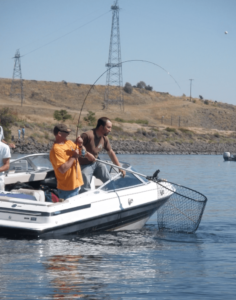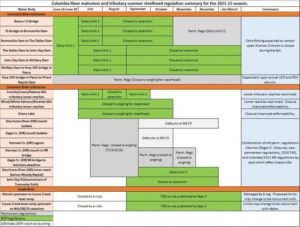
A-run Steelhead Forecast Downgraded Sharply, Spiking Concerns
“Terrible,” “meager,” “darkest hour,” “worst on record.”
Those are some of the words being used to describe this summer’s Columbia-Snake steelhead run, adjectives backed up by last Monday’s jarring runsize downgrade.
A technical advisory committee dropped the A-run forecast from 89,200 fish at Bonneville this season to just 35,000.
For perspective, even over the past five years of poor runs, 89,000 has been roughly the average annual number of these Central Idaho, Northeast Oregon and Eastern Washington steelhead counted at the dam – 166,541 is the 10-year average, with as many as 318,125 returning in 2011.

When TAC revised the forecast, the committee also said that the 21,509 steelhead counted at Bonneville through August 15 was the fewest to that point of the run all the way back to 1943.
Since then, 2021’s run has fallen off even that year’s pace. As of yesterday, just 24,395 have been tallied at the dam since July 1, when the counting period for the stock begins. (By the same time in 1943, 28,008 had.)
Today’s update from TAC also notes that “the cumulative unclipped [steelhead] passage (12,461) is the lowest since clipped/unclipped counting began in 1994.”
Wild steelhead advocates have been sounding the alarm, calling on Oregon’s and Washington’s Fish and Wildlife Commissions to instate further conservation measures, with at least one Oregon fly fishing guide cancelling his season on the Deschutes – efforts meant to draw attention to the plight of this year’s run.
“I’m sorry to have to do this because I look forward to fishing with all of you each year, but I don’t feel that conducting our regular business this year is ethical,” said Jeff Hickman of Fish The Swing in a letter to clients he posted. “The risk of killing even one wild steelhead is too many. The river has none to spare.”
While very warm water temperatures in the Columbia – a salmonid-unfriendly 68-plus degrees continuously at Bonneville’s forebay since late June’s hellwave – are probably slowing the run down somewhat as it heads upstream, WDFW’s Ryan Lothrop in Vancouver didn’t expect much to change in what is shaping up to be “a very poor return.”
Lothrop defended managers’ measures in place this summer (and recent ones) to protect A- as well as B-run steelhead, including closing the mainstem Columbia to steelhead retention from the mouth to The Dalles Dam in August and beginning September 1 from The Dalles to Pasco; the closure of cool Lower Columbia trib mouths in August; closure of thermal refuges on both sides of the Columbia Gorge such as Drano Lake and the Deschutes mouth through the bulk of summer; one-hatchery-steelhead limits where fisheries are open before and after typical passage peaks; and night closures.
Early this afternoon, WDFW also announced that the upper end of Drano would switch to bank fishing/hand-cast lines only to reduce impacts on steelhead.
And later in the afternoon Washington’s Fish and Wildlife Commission announced a special Friday morning web conference with Oregon commissioners to talk over “steelhead fisheries within the Columbia River given the low returns to-date” and “next steps for steelhead recovery, including elements beyond harvest.”

Lothrop says impacts on A- and B-runs are projected to be just .6 percent and 1.0 percent out of a possible 2.0 percent allowed for each stock under the preseason fishing plan.
“Most of the public is unaware of all the precautionary actions we took this year (and since 2017),” he said. “All that is left are a few micro-adjustments that wouldn’t provide much reduction in impacts.”
Lothrop points to the Pacific as “probably the biggest driver” with this year’s poor return.
“We are noticing the hatchery component is returning at a lower rate than the wilds, which is common to see under challenging environmental variables. Sometimes some low hatchery program returns can occur due to water condition issues, but this is coming across the board a bit,” he says.
Anglers and others have been pushing hard for an Idaho Republican’s sweeping, comprehensive plan to breach the lower four dams on the Snake River in a bid to improve steelhead and salmon returns, some of which are forecast to reach the quasi-extinct category by 2025. The proposal is supported by Oregon Governor Kate Brown, but few other high-ranking members of her caught-flat-footed party.
It’s too early to update this year’s B-run steelhead forecast –7,600, with 1,000 of those natural origin – as those fish tend to primarily return in September and October and have a different life history than A-runs in that they spend a year longer in the ocean, but Lothrop says that so far “there is no reason to suspect our already low forecast is off to the same magnitude as A-index.”
Indeed, the poor A-run has managers further upstream prepping fishermen for a dismal autumn and winter.
“Anglers up my way in the Snake Basin should expect very little opportunity this year for steelhead,” says WDFW’s Chris Donley in Spokane this morning.
Better to focus on more abundant fall Chinook on Washington’s Snake and Idaho’s Snake and other tribs and coho on the Gem State’s Clearwater.
